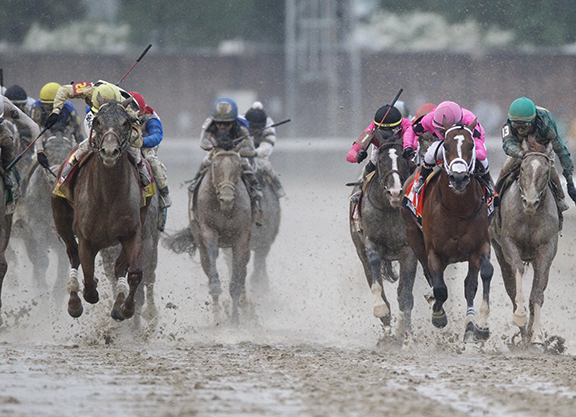By Chris McGrath
May Day means different things to different people. Children dancing round a pole on an English village green. A red flag flying on the global equivalent of Labor Day. But it is with the mariner in distress that many Thoroughbred breeders will most identify-because a foal delivered in May is apt to prompt inward recourse to the phonetic signal for the French “m'aidez”. Help me!
The best they can apparently hope for is another West Coast (Flatter), unraced at two before pouncing on punchdrunk Triple Crown survivors in the GI Travers; or otherwise maybe another Accelerate (Lookin At Lucky), who did not manage his first Grade I until the age of five but then promptly won another four.
Yet that kind of anecdotal paradigm can be grievously misleading. There are late foals and late foals. A horse built like Accelerate might well have profited from time to mature, had he been born one minute past midnight on January 1. All Thoroughbreds should be treated as flesh and blood, not sheets of data.
The fact is that as many as four of the 19 sophomores forward enough to contest the Kentucky Derby on Saturday had yet to celebrate their third birthday. Oh, and those four included the first three past the past: poor Maximum Security (New Year's Day), foaled May 14; Country House (Lookin At Lucky), May 8; and Code Of Honor (Noble Mission {GB}), May 23.
Everyone knows the story of a debate between the Windfields brains trust in the late spring of 1960. Should they try to prolong Natalma's racing career, by giving her surgery on a chipped knee; or rush her into a late cover? The farm's new stallion was proving very fertile so, according to Joe Thomas, they said: “Oh, what the hell: why don't we breed her to Nearctic and if she gets in foal, okay; and if she doesn't, then maybe we'll try to get her back.”
Though it was nearly July before Natalma could get up to Canada, that decision was vindicated on May 27, 1961, by the delivery of the most influential Kentucky Derby winner of the modern era. Northern Dancer, of course, was notoriously a pocket battleship. But that's the point. Precocity is a physical and mental function of an individual.
Of countless elite performers foaled in April or May, some admittedly excelled with maturity. But many were also top-class 2-year-olds, and in eras when that was a matter of toughness as well as class. Horses are campaigned rather differently nowadays but Code Of Honor, for instance, still managed a Grade I podium last year, though a May 23 foal by a horse who himself blossomed only as a 5-year-old.
And just look at this. Of the 20th Century's top 20 American Thoroughbreds, according to an expert panel, the foaling dates were: 1. War Admiral, March 29; 2. Secretariat, March 30; 3. Citation, April 11; 4. Kelso, April 4; 5. Count Fleet, March 24; 6. Dr Fager, April 6; 7. Native Dancer, March 27; 8. Forego, April 30; 9. Seattle Slew, February 15; 10. Spectacular Bid, February 17; 11. Tom Fool, March 31; 12. Affirmed, February 21; 13. War Admiral, May 2; 14. Buckpasser, April 28; 15. Colin [1905, no foaling date to hand]; 16. Damascus, April 14; 17. Round Table, April 6; 18. Cigar, April 18; 19. Bold Ruler, April 6; 20. Swaps, March 1. If you divide the foaling season in mid-March, halfway between January and May, only four of 19 specified dates fell in the first half.
It's not hard to see why this should be. The later the foal, the better the pasture and the more benign the weather. To be fair, appetite for early foals appears to be more extreme in Europe, reflecting an associated and witless addiction to so-called “commercial” dash-a plebeian brand, wholly inferior to the American grail of speed you can actually carry two turns. Yet at one recent Royal Ascot, three of the six juvenile races were won by May foals.
If pre-trainers and trainers start with the date on the passport, rather than the animal in front of them, then the presumption that later foals need time can be self-fulfilling. Yet in kicking on with early foals, they are building on foundations laid in sparse grazing and short days.
The Kentucky Derby-as we were reminded on Saturday-is the ultimate bareknuckle test of an adolescent horse. And, besides Country House and Northern Dancer, it has been won before their third birthday by Lucky Debonair (May 2); Mine That Bird (May 10); Cannonade (May 12); Spend A Buck (May 15); Thunder Gulch (May 23); and Exterminator (May 30).
Mucho Macho Man (Macho Uno) was born as late as June 15 and, as a 17-hand aircraft carrier who only reached his peak at five, had the profile of the big, backward beast unlikely to get sufficient seasoning for the Classics. But he was able to finish second in two Grade IIs as a juvenile, and third in the Kentucky Derby. Equally, Air Force Blue–one of the most accomplished juveniles ever trained by Aidan O'Brien–was a May foal.
One of the frustrations of observing this business at close quarters is to see massive investment sometimes predicated on the most fatuous grounds. That's not necessarily the investors' fault: they are busy people, accustomed at every level of their business to delegating decisions to specialists. But while some plainly benefit from exceptionally perceptive and independent counsel, others find themselves relying on glib, recycled supposition.
So while he received the ultimate birthday present five days early, let's hope that Country House-along with the other May foals he joined in the finish on Saturday-can help the rest of us grow up a little.
Otherwise, as with every attempt to reduce the Thoroughbred to a formula, we will soon be sending out distress signals again.
Not a subscriber? Click here to sign up for the daily PDF or alerts.






